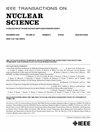SEU Rate Calculation Using In-Flight Proton Detection: Methodologies and Evaluation of Time-Scale Variability
IF 1.9
3区 工程技术
Q3 ENGINEERING, ELECTRICAL & ELECTRONIC
引用次数: 0
Abstract
The real-time single event upset (SEU) rate in low Earth orbit (LEO) is subject to fluctuations influenced by the short-term dynamics of protons in radiation belts and differences in flight trajectories. This study presents three streamlined methodologies for calculating SEU rates using real-time in-flight proton detection rather than relying on models or historical data. Moreover, to evaluate the performance of these methods, data from the National Space Science Center (NSSC) space particle radiation effect comprehensive measuring instrument (SPRECMI) were utilized. This dataset demonstrates that proton contributions predominantly drive the SEUs as established in prior research. The analysis reveals that accuracy and responsiveness exhibit reverse trends across different time scales with a 6-h interval identified as the optimal balance for this SEU monitoring. Furthermore, detailed assessments of methodology performance including error, concordance, and applicability limitations on daily and 6-h scales are provided. This approach to calculating SEU rates supports both the study of space weather impacts on SEUs and the engineering challenges of real-time SEU risk warnings.利用飞行中的质子探测计算SEU速率:方法和时间尺度变异性的评估
近地轨道实时单事件扰动(SEU)速率受辐射带内质子短期动力学和飞行轨迹差异的影响而波动。本研究提出了三种简化的方法,利用实时飞行中的质子探测而不是依赖模型或历史数据来计算SEU率。利用国家空间科学中心(NSSC)空间粒子辐射效应综合测量仪(SPRECMI)的数据,对这些方法的性能进行了评价。该数据集表明,质子的贡献主要驱动seu,正如先前的研究所建立的那样。分析表明,准确度和响应性在不同的时间尺度上呈现相反的趋势,6小时的间隔被认为是这种SEU监测的最佳平衡。此外,还提供了详细的方法性能评估,包括误差、一致性和每日和6小时尺度的适用性限制。这种计算SEU率的方法既支持空间天气对SEU的影响研究,也支持实时SEU风险预警的工程挑战。
本文章由计算机程序翻译,如有差异,请以英文原文为准。
求助全文
约1分钟内获得全文
求助全文
来源期刊

IEEE Transactions on Nuclear Science
工程技术-工程:电子与电气
CiteScore
3.70
自引率
27.80%
发文量
314
审稿时长
6.2 months
期刊介绍:
The IEEE Transactions on Nuclear Science is a publication of the IEEE Nuclear and Plasma Sciences Society. It is viewed as the primary source of technical information in many of the areas it covers. As judged by JCR impact factor, TNS consistently ranks in the top five journals in the category of Nuclear Science & Technology. It has one of the higher immediacy indices, indicating that the information it publishes is viewed as timely, and has a relatively long citation half-life, indicating that the published information also is viewed as valuable for a number of years.
The IEEE Transactions on Nuclear Science is published bimonthly. Its scope includes all aspects of the theory and application of nuclear science and engineering. It focuses on instrumentation for the detection and measurement of ionizing radiation; particle accelerators and their controls; nuclear medicine and its application; effects of radiation on materials, components, and systems; reactor instrumentation and controls; and measurement of radiation in space.
 求助内容:
求助内容: 应助结果提醒方式:
应助结果提醒方式:


